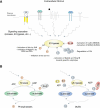The ubiquitination code: a signalling problem
- PMID: 17355622
- PMCID: PMC1832185
- DOI: 10.1186/1747-1028-2-11
The ubiquitination code: a signalling problem
Abstract
Ubiquitin is a highly versatile post-translational modification that controls virtually all types of cellular events. Over the past ten years we have learned that diverse forms of ubiquitin modifications and of ubiquitin binding modules co-exist in the cell, giving rise to complex networks of protein:protein interactions. A central problem that continues to puzzle ubiquitinologists is how cells translate this myriad of stimuli into highly specific responses. This is a classical signalling problem. Here, we draw parallels with the phosphorylation signalling pathway and we discuss the expanding repertoire of ubiquitin signals, signal tranducers and signalling-regulated E3 enzymes. We examine recent advances in the field, including a new mechanism of regulation of E3 ligases that relies on ubiquitination.
Figures




References
LinkOut - more resources
Full Text Sources
Other Literature Sources
Miscellaneous

